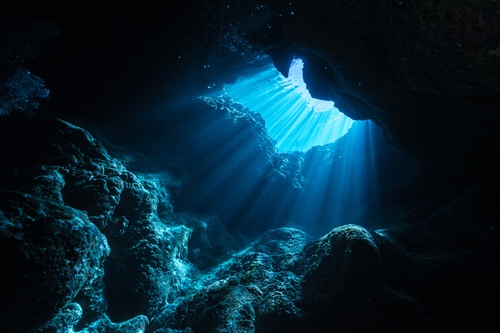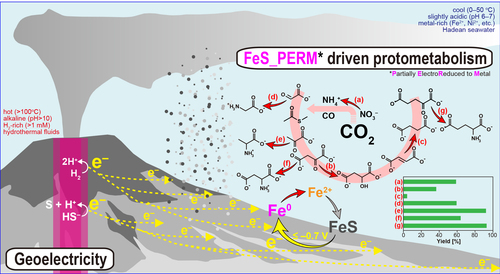Research Highlights
Electricity-Driven Undersea Reactions May have Been Important for the Emergence of Life
[Press Release]
Tokyo Tech team discovers unusual chemical reactions in deep sea environment laboratory simulations.
 The research group has proposed an effective mechanism to utilize the chemical energy generated by hot hydrothermal fluids gushing out of hydrothermal vents on Earth's early ocean floor for the synthesis of biomolecules.
The research group has proposed an effective mechanism to utilize the chemical energy generated by hot hydrothermal fluids gushing out of hydrothermal vents on Earth's early ocean floor for the synthesis of biomolecules.
Credit: ELSI
Though it remains unknown how life began, there is a community of scientists who suspect it occurred in or around deep sea hydrothermal environments. At such sites, water heated by contact with hot rocks from Earth's mantle flows into the lower ocean, passing over and through minerals which are themselves precipitated by the interaction of this hot water with cold seawater. The minerals often include metal sulfides, such as iron sulfide, also known as pyrite or fool's gold. As they precipitate, these mineral precipitates begin to form channels for the hot vent water, and since the metal-containing minerals are electrically conductive and the compositions of the vent water and ocean water are different, an electrical gradient is created--something like a natural battery--with electric current flowing from the vent water through the minerals and into the ocean. A team led by Tokyo Institute of Technology/Earth-Life Science Institute (ELSI) scientists have now shown via careful laboratory experiments that this current can reduce the metal sulfide minerals to native metals and mixed metal sulfide/metal conglomerates, which in turn can reduce and catalyze the reduction of various organic compounds.
The team led by Norio Kitadai, an affiliated scientist of the Tokyo Institute of Technology/Earth-Life Science Institute (ELSI) as well as a scientist at the Japan Agency for Marine-Earth Science and Technology (JAMSTEC), produced a set of electrochemical reactions in the laboratory that are suspected to have been generated in early ocean floor hydrothermal vent environments. They demonstrated that metal sulfides, including those of iron, copper, lead, and silver (some of which are common constituent minerals in hydrothermal vent environments), were converted to native metals by electroreduction. Complexes of metal sulfide and reduced metal were also produced during the process. It was also discovered that several organic chemical reactions indispensable in modern life were promoted by these complexes. The authors believe the metals and metal sulfides served as reducing agents and catalysts for these reactions.
This research identifies a new mechanism for the creation of organic compounds driven by hydrothermal electricity generation in hydrothermal fluids. An exciting implication of this work is that, since electrical current appears to be universally generated in deep-sea hydrothermal vent environments on Earth, anywhere such hydrothermal processes occur throughout the cosmos should likewise promote this kind of chemistry. Indeed, recent astronomical and spacecraft-based observations suggest there may be vigorous hydrothermal activity on the moons of Saturn and Jupiter (Enceladus and Europa), and hydrothermal activity was likely common on early Mars. Further research on the effects of various metals and electric gradients is expected to unveil much more about the environmental conditions that can facilitate prebiotic chemistry. This could ultimately lead to a better understanding of the universality and similarity of life in the universe.
 Conceptual diagram of a hydrothermal vent assumed to have been widely distributed on the Hadean ocean floor. Hydrogen and hydrogen sulfide contained in hydrothermal fluids are oxidized inside the vent, and the generated electrons flow away from the vent along the electric potential difference between hydrothermal fluids and seawater, which generates a steady electric current (hydrothermal electricity generation).
Conceptual diagram of a hydrothermal vent assumed to have been widely distributed on the Hadean ocean floor. Hydrogen and hydrogen sulfide contained in hydrothermal fluids are oxidized inside the vent, and the generated electrons flow away from the vent along the electric potential difference between hydrothermal fluids and seawater, which generates a steady electric current (hydrothermal electricity generation).
Credit: Kitadai et al. (2019) Science Advances
Reference
Norio Kitadai1,2*, Ryuhei Nakamura2,3, Masahiro Yamamoto1, Ken Takai1,2, Naohiro Yoshida2,4, Yoshi Oono5, Metals likely promoted protometabolism in early ocean alkaline hydrothermal systems, Science Advances, DOI: 10.1126/sciadv.aav7848
1. Super-cutting-edge Grand and Advanced Research (SUGAR) Program, Institute for Extra-cutting-edge Science and Technology Avant-garde Research (X-star), Japan Agency for Marine-Earth Science and Technology (JAMSTEC), 2-15 Natsushima-cho, Yokosuka 237-0061, Japan.
2. Earth-Life Science Institute, Tokyo Institute of Technology, 2-12-1 Ookayama, Meguro-ku, Tokyo 152-8550, Japan.
3. Biofunctional Catalyst Research Team, RIKEN Center for Sustainable Resource Science, 2-1 Hirosawa, Wako, Saitama 351-0198, Japan.
4. Department of Environmental Chemistry and Engineering, Tokyo Institute of Technology, 4259 Nagatsuta, Midori-ku, Yokohama, Kanazawa 226-8503, Japan.
5. Department of Physics, University of Illinois at Urbana-Champaign, 1110 W. Green Street, Urbana, IL 61801-3080, USA.
Contacts
Thilina Heenatigala
Director of CommunicationsEarth-Life Science Institute (ELSI),
Tokyo Institute of Technology
E-mail: thilinah@elsi.jp
Tel: +81-3-5734-3163/ Fax +81-3-5734-3416
Norio Kitadai
Affiliated Scientist
Earth-Life Science Institute (ELSI),
Tokyo Institute of Technology
E-mail: nkitadai@elsi.jp
Tel: 046-867-9708
(This article also appears in Tokyo Tech official website.)












